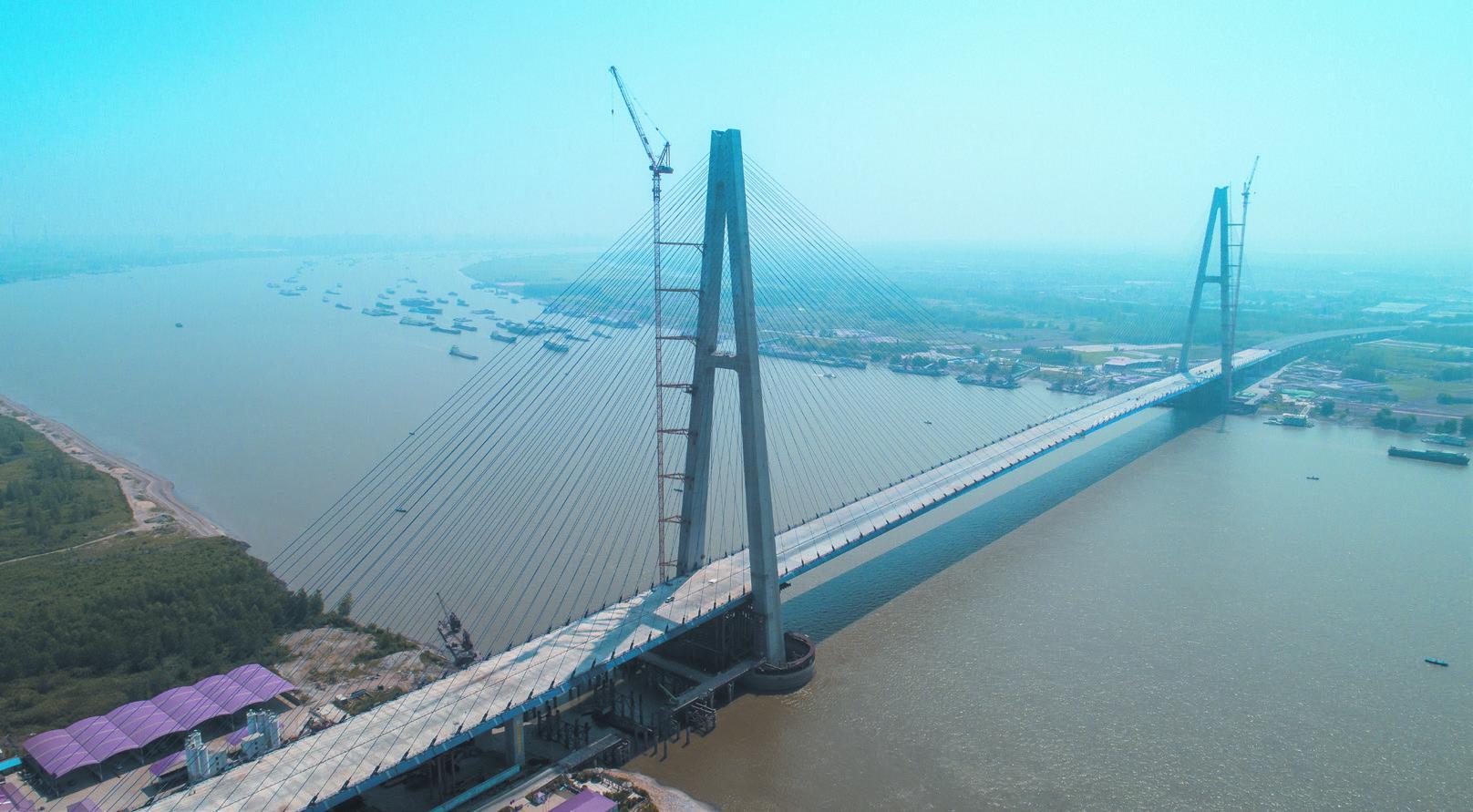Bridging the Gap

Bridging the Gap
The Qingshan Yangtze River Road Bridge in Wuhan, central Chinas Hubei Province, undergoes asphalt paving on September 8. The worlds longest cable-stayed bridge at 7,548 meters, the 10-lane two-way bridge can “swing”between the giant supporting beams on the sides to offset the impact of strong winds and earthquakes. It will open to traffi c next year.
Having More Fun
The Chinese are engaging in increasingly diverse leisure activities, according to a recent report released by the China Tourism Academy.
Based on a survey of 10 cities including Beijing, Shanghai and Guangzhou in south Chinas Guangdong Province, the report on residents recreation development said consumption-based leisure activities are the primary choice of urban and rural residents, accounting for 40 percent of the total options. These include shopping, dining and beauty treatments.
Travel has become a major option for recreation, with around 30 percent of the respondents choosing to travel in their spare time. The proportion of medium- and shortdistance trips has risen markedly.
Cultural, sports and fi tness activities are also indispensable parts of residents recreation, accounting for 20 percent of the leisure activities of urban residents.
However, urban and rural residents still lack leisure time. More than one third of the surveyed urban residents work for over nine hours on weekdays.
The report suggested more efforts be put to ensure paid vacation and improve the quality of recreation.
Call for Stability
Lam Cheng Yuet-ngo, Chief Executive of Hong Kong Special Administrative Region, has expressed opposition to foreign legislaturesinterference in Hong Kongs internal affairs in any form.
She made the remarks on September 10 at a press briefi ng in response to the introduction of the so-called Hong Kong Human Rights and Democracy Act bill in the U.S. Congress. If passed, the bill would mandate an annual assessment of Hong Kongs autonomy to decide if it will continue to enjoy special U.S. trade and economic benefi ts.
Lam also called for an end to vandalism of infrastructure. Hong Kongs airport and the railway system are its lifeblood, closely related to the daily life of local residents, she said, adding that the escalated violence will not solve social problems but exacerbate confl icts, rifts and hatred.
She urged all sectors of the Hong Kong community to work together to stop the violence.
Rule of law is an important core value of Hong Kong and the government will investigate all violent incidents according to law, she said.
Lam also said the government is sincere about engaging in dialogue with people from different backgrounds and she and other offi cials will reach out to the community. She will also strive to make the dialogue open to the public.
Local Power
Lawmakers are mulling law amendments to give local legislatures more power in due course.
The Commission of Legislative Affairs of the Standing Committee of the National Peoples Congress(NPC), the top legislature, said research on the issue is underway.
Provincial-level peoples congresses can enact local decrees, provided they do not contravene any provision of the Constitution, national laws or administrative regulations.
They are also given the power to formulate guidelines for implementing laws such as the Election Law.
Currently, there are over 12,000 effective local decrees.
Delegating legislative power to local authorities is a milestone in the development of Chinas legislative system. Before reform and opening up, the NPC alone had legislative powers. Since 1979, provincial-level peoples congresses and their standing committees have been granted legislative powers.
Waste Import
Solid waste imports in China continued to decline in the fi rst eight months of 2019 with the implementation of the ban on foreign garbage, according to customs data on September 8.
Such imports dropped 29 percent year on year to 9.7 million tons in the period, the General Administration of Customs of China said.
In August alone, imports of plastic, paper and metal waste totaled 1.15 million tons, down from 1.26 million tons in July.
China began importing solid waste as a source of raw materials in the 1980s and for years has been the worlds largest importer, despite its weak capacity in garbage disposal. Some companies have prof tied by illegally bringing foreign waste into the country, posing a threat to the environment and public health.
As part of its anti-pollution efforts, the government decided to phase out such imports by the end of 2019, except for those containing resources that are not substitutable. The government has also moved to improve the domestic solid waste recycling rate.
Cybersecurity Leader
China will continue to lead the growth of the global cybersecurity market in the coming fi ve years, with the market size to surge to$17.9 billion in 2023, according to International Data Corp.
The compound annual growth rate of Chinas cybersecurity spending from 2019 to 2023 will be 25.1 percent, compared with the global average of 9.44 percent, the global market research firm said in a recent report.
Chinas cybersecurity spending in 2019 will reach $7.35 billion, of which hardware will claim a lions share of 62.8 percent. Software and service will account for 16.7 percent and 20.5 percent of the total, respectively.
Government, communications and fi nancial sectors will see the most cybersecurity spending, as they will account for roughly 60 percent of the sum.
China is already the worlds second in terms of cybersecurity spending, but still lags behind the global average in terms of its proportion to the total information technology spending.
According to the report, global cybersecurity spending will surpass$150 billion in 2023.

Turning Over a New Leaf
Tourists take a selfi e in a park built on an abandoned coal mine in Tangshan, north Chinas Hebei Province, on September 5. The project began in August 2018 as part of a local environmental improvement campaign.
Lunar Exploration
Yutu-2, the rover of Chinas Change-4 lunar probe, had driven 284.66 meters on the far side of the moon by September 6 before it switched to the dormant mode for the lunar night, according to the Lunar Exploration and Space Program Center of the China National Space Administration.
The Change-4 probe, launched on December 8, 2018, made the fi rst-ever soft landing on the Von Karman Crater in the South PoleAitken Basin on the far side of the moon on January 3.
A lunar day equals 28 days on Earth. The Change-4 switches to the dormant mode during the lunar night due to lack of solar power.
During the ninth lunar day of the probe on the moon, the scientifi c instruments on the lander and rover of the Change-4 worked well, and a new batch of 2.9 GB scientifi c detection data was sent to the core research team for analysis, the administration said.
As a result of the tidal locking effect, the moons revolution cycle is the same as its rotation cycle, and the same side always faces Earth. The far side of the moon has unique features, and scientists expect the Change-4 could bring breakthrough fi ndings.
The scientifi c tasks of the Change-4 mission include lowfrequency radio astronomical observation, surveying the terrain and landforms, detecting the mineral composition and shallow lunar surface structure, and measuring neutron radiation and neutral atoms.
An Unforgettable Lesson
Tang Shangjun tutors a student in physics at his home in Wuhan Village in Yiyang, central Chinas Hunan Province, on September 7. The 92-year-old retired teacher started voluntarily teaching children left behind in the mountainous area by their migrant parents in 1997.

Water Consumption
Chinas total annual water use is around 600 billion cubic meters, and its water use effi ciency has been improving, Wei Shanzhong, Vice Minister of Water Resources, said on September 7.
In 2018, 66.8 cubic meters of water was used for 10,000 yuan ($1,410) of GDP and 41.3 cubic meters for 10,000 yuan of value-added industrial output, down 18.9 percent and 20.9 percent from 2015, respectively.
The effective utilization coeff ciient of farmland irrigation water reached 0.55 in 2018, 0.018 higher than that of 2015, according to Wei.
New-Energy Vehicles
New energy carmakers in China had a tough fi rst half of the year as shrinking government subsidies and rising competition weighed on sales.
Only three auto companies which also produce new-energy vehicles (NEVs) saw net profi ts rise in the fi rst half of the year, while most fi rms saw a slump in profi ts as sales failed to meet expectations.
Data from the China Association of Automobile Manufacturers showed that total sales of NEVs in China went down 4.7 percent year on year in July, the fi rst decrease in nearly two years.
NEV sales have been under pressure due to reasons such as cuts in government subsidies and a fall in oil prices, Cui Dongshu, Secretary General of Chinas Passenger Car Association, told China Automotive News.
In a bid to encourage the highquality development of the sector, China has been phasing out subsidies for NEV purchases, which were put in place in 2010 to stimulate the popularity of NEVs.
After a three-month transition period ended on June 25, local governments have stopped subsidizing purchases of NEVs except for newenergy buses and fuel cell vehicles.
The measures will support market competition and encourage carmakers to improve their effi ciency, analysts predict.
Traveling Smart
A train equipped with an intelligent locomotive system using 5G and artifi cial intelligence sets off from Xian in northwest Chinas Shaanxi Province on September 4. The system was put into operation through the cooperation of the local railway bureau and Chinas tech giant Huawei.

Mobile Gaming
Overseas markets have become increasingly important to Chinese mobile game developers as they account for a growing share of the industrys revenue, a research report showed.
In 2018, the revenue of Chinas mobile gaming industry from overseas markets totaled 42.12 billion yuan ($5.94 billion), up 30.8 percent year on year, according to iResearch, a market research company.
In addition, overseas markets made up 25.4 percent of the total revenue of Chinas mobile gaming industry, rising by 3.1 percentage points compared to 2017, the report said.
The most popular Chinese mobile gaming categories in the fi rst quarter included MMORPG, action and puzzle games. Brazil was among the regions that saw the biggest increase of products launched by Chinese mobile game developers during the same period.
Chinas domestic market experienced a temporary hiatus when authorities tightened regulations on the mobile gaming industry in 2018, which partly explained the expansion of Chinese mobile games among overseas markets, the report said.
Financial Opening Up
The State Administration of Foreign Exchange (SAFE) announced on September 10 it would abolish the investment quota restrictions for the Qualifi ed Foreign Institutional Investors (QFII) and Renminbi Qualifi ed Foreign Institutional Investors (RQFII) programs to boost fi nancial reforms and opening up.
The two programs have played an important role in the opening up of Chinas fi nancial market, according to SAFE.
Since the implementation of the QFII system in 2002 and the RQFII system in 2011, more than 400 institutional investors from 31 countries and regions have invested in Chinas fi nancial market in this way, according to SAFE.
In the future, foreign institutional investors with corresponding qualifi -cations will only need to go through the registration procedure to remit funds independently to make securities investment.
Foreign investors will fi nd it more convenient to participate in the domestic fi nancial market, and Chinas bond and stock markets will be accepted more easily by the global market, according to SAFE.
This is a major move that aims to deepen the reform and opening up of the fi nancial market, serve as a new pattern of all-around opening up and meet the investment needs of foreign investors in Chinas fi nancial market, said SAFEs chief economist Wang Chunying.
SAFE also said it would continue to deepen the reform of foreign exchange administration, expand opening up, support foreign investors to invest in domestic fi nancial markets and facilitate cross-border investment and fi nancing.
It will also adapt to opening up, guard against the risk of crossborder capital fl ows and protect the countrys economic and fi nancial security.
A Lending Boost
The Peoples Bank of China (PBC) announced on September 6 it will cut the cash that lenders must hold in reserve, releasing about 900 billion yuan ($127 billion) of long-term liquidity to bolster the economy.
The PBC announced a 0.5- percentage-point cut to the reserve requirement ratio (RRR) for fi nancial institutions starting on September 16 to support the real economy and reduce the real cost of social fi nancing.
About 800 billion yuan ($112 billion) will be released from the broad-based RRR cut.
The PBC also announced an additional 1-percentage-point reduction in the RRR for city commercial banks operating only in provincial administrative areas, which will be implemented in two phases on October 15 and November 15, cutting 50 basis points in each phase.
The targeted RRR cut will release 100 billion yuan ($14 billion), with the aim to promote support for small and private enterprises.
The PBC stressed it will continue to implement a prudent monetary policy and will not engage in a deluge of strong stimulus policies in order to create a suitable monetary and fi nancial environment for high-quality development and supply-side structural reform.
The RRR cuts can hedge against the tax period in mid-September and thus the total amount of liquidity in the banking system will remain basically stable, according to the PBC.

Booming Homestays
Tourists in Wulian County of Rizhao, east Chinas Shandong Province, enjoy the scenery from a homestay on September 3. In recent years, the county has focused on boosting the homestay industry to attract more tourists and revitalize the local economy.
Local Bonds
There was an accelerat ion in the issuance of local government bonds at lower interest rates in China during the January-August period amid the countrys efforts to improve fi nancing effi ciency.
New local government bonds worth 2.89 trillion yuan ($407 billion) were issued in the fi rst eight months of the year, accounting for 94 percent of the planned quota for the whole year, which was 34 percentage points higher over a year ago, data from the Ministry of Finance (MOF) showed.
The average issuance interest rate of the new bonds stood at 3.41 percent during this period, down by 0.44 percentage points year on year.
Over 2.2 trillion yuan ($309 billion) worth of new local government bonds were already planned for use, with nearly 40 percent going toward building government-subsidized housing and rebuilding rundown urban areas.
The State Council executive meeting on September 4 decided that all special local government bonds in this years quota must be issued by the end of September and disbursed to projects by the end of October.
Local governments will be urged to ensure that these projects generate activities in the real economy as quickly as possible, the meeting said.
The local government debt balance stood at 21.41 trillion yuan($3 trillion) by the end of August, well within the quota approved by the National Peoples Congress, MOF data showed.

Virtual Tourism
A visitor experiences a VR program at a tourism industry expo, which opened in north Chinas Tianjin Municipality on September 6 and attracted hundreds of enterprises, making it the largest such exhibition to date.

